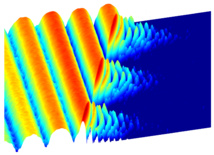
24 May Scientists get to solidify light
Researchers from Princeton University (USA) have managed to solidify light
 A "never-seen" breakthrough that can help to understand the behavior of matter at the quantum level and create new materials.
A "never-seen" breakthrough that can help to understand the behavior of matter at the quantum level and create new materials.
They have managed the solidification of the light collecting photons, light particles, and securing them in a space.
According to the journal Physical Review X, these advances have been made in order to create a device capable of simulating the behavior of subatomic particles, to study them and learn about them.
How they have managed the impossible?
To build the device in question, researchers created a structure that contains 100 billion atoms with superconducting materials, designed to act as a single "artificial atom".
They then placed the artificial Atom near a cable superconductor containing photons. Thanks to the rules of quantum mechanics, photons of cable acquired, as "contagion", some of the properties of artificial Atom, that is, were linked to it in a sense.
This fact changed their behavior, such as photons, which normally do not interact with each other, began to do so. The result was the following: light went on to show a collective behavior unusual and "similar to the phases of matter in liquids and crystals that studies the physics of condensed matter", explains Darius Sadri, another of the protagonists of the advance.
"Here we have created a situation in which light behaves as a particle, in the sense that two photons may interact with great force," added. "In one of the operating modes (evoked), light slosh from one side to another, like a liquid; in the other words, freezes".
The device in question is relatively small, and consists of two parts: one in which artificial Atom remains, and the superconductor cable.
But the researchers believe that, through the expansion device and the number of interactions, the capacity of the machine could be increased so this to simulate more complex systems, from one molecule to a complete material. Future devices with hundreds of parties would observe exotic phases of light, similar to those of the superfluids and insulating materials, are waiting.
![The Ministry of time - season 2 [Blu-ray]](https://viajeroseneltiempo.es/storage/2016/09/El-Ministerio-Del-Tiempo-Temporada-2-Blu-ray-0-260x300.jpg)




![La Teoría Del Todo [Blu-ray] - Stephen Hawking](https://viajeroseneltiempo.es/storage/2016/09/La-Teora-Del-Todo-Blu-ray-0-260x300.jpg)











No Comments